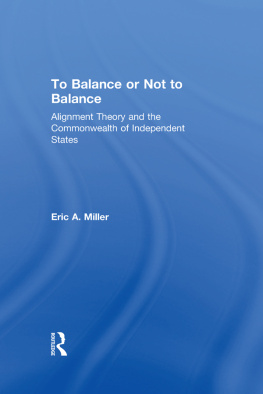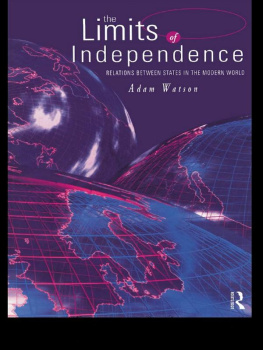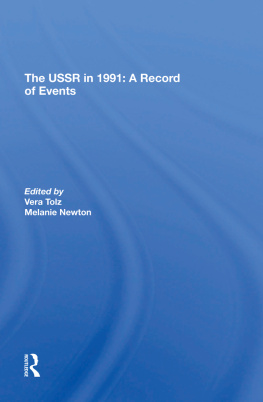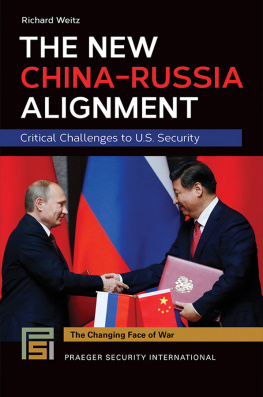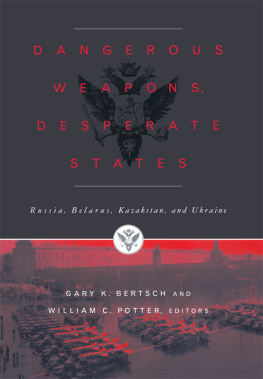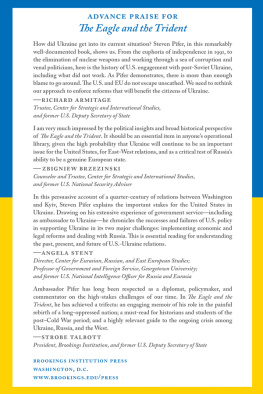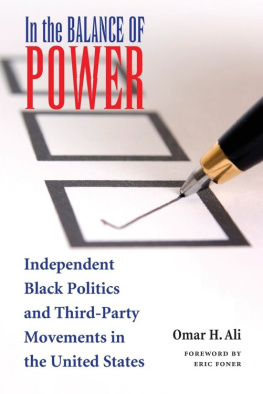TO BALANCE OR NOT TO BALANCE
In loving memory of Stanley Miller
To Balance or Not to Balance
Alignment Theory and the Commonwealth of Independent States
ERIC A. MILLER
National Institute for Public Policy, USA
and
Institute for European, Russian and Eurasian Studies,
George Washington University, USA
First published 2006 by Ashgate Publishing
Published 2016 by Routledge
2 Park Square, Milton Park, Abingdon, Oxon OX14 4RN
711 Third Avenue, New York, NY 10017, USA
Routledge is an imprint of the Taylor & Francis Group, an informa business
Copyright 2006 Eric A. Miller
Eric A. Miller has asserted his right under the Copyright, Designs and Patents Act, 1988, to be identified as the author of this work.
All rights reserved. No part of this book may be reprinted or reproduced or utilised in any form or by any electronic, mechanical, or other means, now known or hereafter invented, including photocopying and recording, or in any information storage or retrieval system, without permission in writing from the publishers.
Notice:
Product or corporate names may be trademarks or registered trademarks, and are used only for identification and explanation without intent to infringe.
British Library Cataloguing in Publication Data
Miller, Eric
To balance or not to balance: alignment theory and the
Commonwealth of Independent States
1. Russia (Federation) - Foreign relations - Ukraine
2. Ukraine - Foreign relations - Russia (Federation)
3. Ukraine - Foreign relations - 1991- 4. Russia (Federation)
- Foreign relations - Uzbekistan 5. Uzbekistan - Foreign
relations - Russia (Federation) 6. Ukraine - Politics and
government - 1991- 7. Uzbekistan - Politics and government
1991
I. Title
327.470477
Library of Congress Cataloging-in-Publication Data
Miller, Eric A.
To balance or not to balance: alignment theory and the Commonwealth of Independent
States / by Eric A. Miller.
p. cm.
Includes bibliographical references and index.
ISBN 0-7546-4334-4
1. Commonwealth of Independent States 2. Nonalignment--Former Soviet republics. 3.
Former Soviet republics--Politics and government. I. Title.
DK1.5.M55 2006
320.94709049--dc22
2005032388
ISBN 9780754643340 (hbk)
Contents
Dr. Eric A. Miller is an International Affairs Analyst with the National Institute for Public Policy in Fairfax, Virginia and a Research Associate at the Institute of European, Russian, and Eurasian Studies at George Washington University in Washington, D.C. He currently provides on-site support for the Missile Defense Agencys International Support Directorate, where he focuses on missile defense issues pertaining to Russia, Ukraine, the Caucasus, and Central Asia. While at National Institute, he has authored studies on U.S. nuclear policy, U.S.-Russian relations, the future of ballistic missiles, efforts to democratize the national security structures of the Republic of Georgia, and Iranian domestic politics and security policy. He also serves as Program Director for the Georgia Forum, a Washington D.C.-based forum dedicated to supporting Georgias political and economic development and promoting stronger U.S.-Georgian relations. He has also served as a consultant and analyst for the Defense Intelligence Agency, U.S. Coast Guard, and Joint Forces Staff College, and held teaching positions at Old Dominion University and Christopher Newport University. His articles, commentary, and reviews on Russia and the Commonwealth of Independent States, U.S. foreign and defense policy, and international relations theory have appeared in leading publications, such as Astropolitics, Defense News, European Security, Financial Times, Janess Intelligence Review, Presidential Studies Quarterly, Problems of Post-Communism, and Security Studies. He holds a B.A. in Political Science from the University of Florida with a certificate in Russian and Slavic Studies, and an M.A. and Ph.D. from Old Dominion University in Norfolk, Virginia.
This book would not have been possible without the assistance and support of a wide range of colleagues, family members, and friends. My colleagues at Old Dominion University were the first to shape and guide the present work. Steve Yetiv was an enduring supporter and critic which forced me to push the bounds of my own theoretical understanding and to challenge long-standing assumptions in international relations theory. Glen Sussman, Stephen Medvic, and Francis Adams were equally challenging colleagues and never let me get too comfortable. Simon Serfaty and David Smith both left indelible marks on my intellectual and professional development, without which this project and many like it could never have been realized. National Institute for Public Policy, under the leadership of Keith Payne, has been a wonderful intellectual home after graduate school, providing me ample time and space to refine this book. Amy Joseph at NIPP was also wonderfully helpful in the final stages of the manuscript. Other colleagues have read portions of this work in various forms, and for their insights I am forever indebted: Rawi Abdelal, Tor Bukkvoll, Stacy Closson, Steven David, Kurt Taylor Gaubatz, Henry Hale, Richard Harknett, Fiona Hill, Charles King, Deborah Sanders, Joanne Tompkins and Cory Welt. For her tireless support and willingness to endure endless drafts, I owe a special debt of gratitude to Dr. Daneta Billau for all that she has given me professionally and personally. Finally, without my parents, Ron and Kathy, I would not be who I am today, and Meredith, Jim, Ryan, Renee, and especially Pooh, have kept my spirits up over the years and my feet firmly on the ground.
Chapter 1
Introduction
With the collapse of the Soviet Union in December 1991, fifteen newly independent states were thrust onto the international stage some more ready and able than others. All had been part of the Soviet Union for most of the twentieth century (and many integrated during the Tsarist period in the nineteenth century). That is to say, all but one Russia had been subjugated to a Russian-dominated empire. Nonetheless, vast cultural, historical, and geographical differences existed, and the political and economic trajectories of these countries were anything but clear. Since independence, some states of the former Soviet Union embraced their newfound independence, while others were reluctant to step from the shadow of the bear.1 This book focuses primary attention on those states that decided to remain in the Commonwealth of Independent States (CIS), the loosely-associated political, military, and economic union that succeeded the Soviet Union.2
Despite the importance of the former Soviet region and the unprecedented independence of these new states, few studies have sought to understand their foreign policy in a theoretical and conceptual fashion.3 A growing body of literature examines the foreign policies of former Soviet republics, but these studies tend to focus on bilateral or regional dynamics as opposed to developing broader frameworks that are applicable throughout the region.4 Thus, while some have argued that a new geopolitical pluralism emerged within the former Soviet Union, our knowledge and understanding of the forces underlying such developments remain underdeveloped.5 This book explores why some CIS states cooperated with Russia while others did not in particular, by focusing on alignment patterns between these states and Russia.

